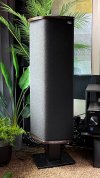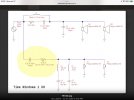There were various iterations of the TW-1 that used different drivers in them. The ones pictured in
@mhardy6647's TW-1s are the Heppner 4846-SD. The tweeters are the Philips AD0162-T8. Earlier TW-1s used a Philips hexagonal-framed woofer and different Philips tweeters.
As far as the 'transmission line' design, these are basically a bass reflex design with very short port tubes. The port tubes are just 2" diameter PVC pipe about 7.25" long. The enclosure volume is around 1.75 cu ft with a port tune of around 35 Hz.
The enclosure is tightly filled with polyfill to control the resonance of the sonotube and the reflections from the port tubes and bottom of the enclosure. The bottom half of the cabinet is stuffed with a higher density polyfill than the upper half and it's in there so tight that little—if any—sound comes out of the ports at all.
Example response of the Heppner woofer:
Nearfield response of ports with no fill in the cabinet:
The schematic below is for the TW-1 XO (from units with serial numbers of about 23xxx):
These are hard to service because the drivers are glued and screwed in place. The sealant around the woofers and tweeters is some butyl rubber substance that is very tough to remove. The 'wood' part of the cabinet, the dihedral front panels, is 1970's style MDF. It's more like chipboard than anything else and it is very porous and breaks apart very easily. Removing the drivers if the XO or drivers need service will damage the material.
You can see in the pictured speaker above on the left of the top cap that the 'wood' is splitting. It's not really wood but some sort of very thick fiberboard with a woodgrain appearance to it. It's doweled and glued to the top of the enclosure and there is no way to get it off without destroying it. The only way to gain entrance to the inside to service the XO is to take out the woofers. Later versions used a threaded steel rod that ran from the bottom plate to the top with a nut on the bottom so that the top plate could be removed to access the XO. Those versions had real Oak for both the bottom and top plates.
Overall, from a subjective point of view, these are very nice speakers. They have a large and enveloping sound field to them and are not bright or fatiguing. Since they only have two 6.5 inch woofers they are a bit light on the low end. When combined with the very rare Time Bass dual eight inch woofer bass modules, they have good low end extension that really rounds out their presentation.





